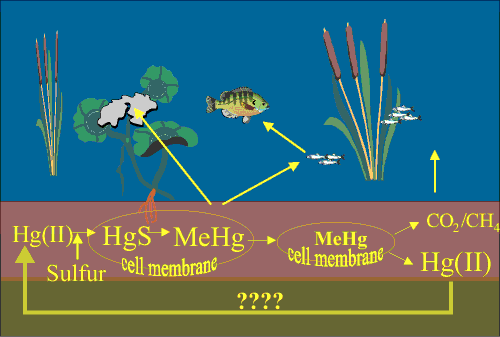Mercury in Aquatic Ecosystems
Mercury occurs naturally in the environment and cycles among the atmosphere, water, and sediments. Human activities such as coal burning power plants and waste incineration increase the amount of mercury cycling in the environment. Since the industrial revolution, anthropogenic mercury emissions have increased atmospheric mercury levels about threefold, causing corresponding increases in mercury levels in terrestrial and aquatic ecosystems.
Mercury that is released into the atmosphere can be transported long distances and deposited in aquatic ecosystems, where it is methylated to methylmercury. Mercury is a neurotoxicant, to which the human fetus is very sensitive. Methylmercury is an organic form of mercury, the most toxic form, and the form that bioaccumulates in fish. Wildlife and humans are exposed primarily through consumption of contaminated fish. The factors that make some aquatic ecosystems susceptible to this bioaccumulation, however, are unknown, making protection of human health and the health of fish-eating wildlife a challenge.
Research focuses on the processes of mercury methylation and accumulation in aquatic ecosystems, factors that determine ecosystem susceptibility, and investigation of whether reduced emissions will reduce mercury accumulation in susceptible ecosystems.
- National and Regional Assessments of Mercury Occurrence and Cycling in the Environment
- Mercury Experiment to Assess Atmospheric Loading in Canada and the United States (METAALICUS)
- Mercury Cycling in Aquatic Ecosystems

Aquatic ecosystems across the Nation are being studied to identify the factors
that control where and when mercury accumulates to toxic levels in the food chain |
Program Headlines Related to Mercury Research
Fact Sheets
More information on Mercury Research
New Publications
Upcoming Publications
- Uptake and retention of atmospheric Hg(II) by boreal forest plants: Graydon, J.A., St. Louis, V., Lindberg, S., Hintelmann, H., and Krabbenhoft, D.P., Environmental Science and Technology (IN PRESS).
- Mercury sources, distribution and bioavailability in the North Pacific Ocean--Insights from data and models: Sunderland, E.M., Krabbenhoft, D.P., Moreau, J.W., Strode, S.A., and Landing, W.M., Global Biogeochemical Cycles, doi:10.1029/2008GB003425 (IN PRESS).
- A comparison of methyl mercury production and distribution in sediments of the Congaree and Edisto River Basins, South Carolina, 2004-2006: Bradley, P.M., Chapelle, F.H., and Journey, C.A., U.S. Geological Survey Scientific Investigations Report 2009-5021, 9 p (IN PRESS).
Newly Published
- Mercury sources, distribution, and bioavailability in the North Pacific Ocean--Insights from data and models: Sunderland, E.M., Krabbenhoft, D.P., Moreau, J.W., Strode, S.A., and Landing, W.M., 2009, Global Biogeochemical Cycles, v. 23, no. 2, p. 1-14, GB2010, doi:10.1029/2008GB003425.
- Mercury cycling in stream ecosystems--1. Water column chemistry and transport: Brigham, M.E., Wentz, D.A., Aiken, G.R., and Krabbenhoft, D.P., 2009, Environmental Science and Technology, doi:10.1021/es802694n (Advanced Web release).
- Mercury cycling in stream ecosystems--2. Benthic methylmercury production and bed sediment-pore water partitioning: Marvin-DiPasquale, M., Lutz, M.A., Brigham, M.E., Krabbenhoft, D.P., Aiken, G.R., Orem, W.H., and Hall, B.D., 2009, Environmental Science and Technology, doi:10.1021/es802698v (Advanced Web release).
- Mercury cycling in stream ecosystems--3. Trophic dynamics and methylmercury bioaccumulation: Chasar, L.C., Scudder, B.C., Stewart, A.R., Bell, A.H., and Aiken, G.R., 2009, Environmental Science and Technology, doi:10.1021/es8027567 (Advanced Web release).
- Mercury isotopic composition of hydrothermal systems in the Yellowstone Plateau volcanic field and Guaymas Basin sea-floor rift: Sherman, L.S., Blum, J.D., Nordstrom, D.K., McCleskey, R.B., Barkay, T., and Vetriani, C., 2009, Earth and Planetary Science Letters, v. 279, no. 1-2, p. 86-96, doi:10.1016/j.epsl.2008.12.032.
- Experimental removal of wetland emergent vegetation leads to decreased methylmercury production in surface sediment: Windham-Myers, L., Marvin-Dipasquale, M., Krabbenhoft, D.P., Agee, J.L., Cox, M.H., Heredia-Middleton, P., Coates, C., and Kakouros, E., 2009, Journal of Geophysical Research-Biogeosciences, v. 114, G00C05, doi:10.1029/2008JG000815.
- Environmental factors affecting mercury in Camp Far West Reservoir, 2001-03: Alpers, C.N., Stewart, A.R., Saiki, M.K., Marvin-DiPasquale, M., Topping, B.R., Rider, K.M., Gallanthine, S.K., Kester, C.A., Rye, R.O., Antweiler, R.C., and DeWild, J.F., 2008, U.S. Geological Survey Scientific Investigations Report 2006-5008, 358 p.
|

|